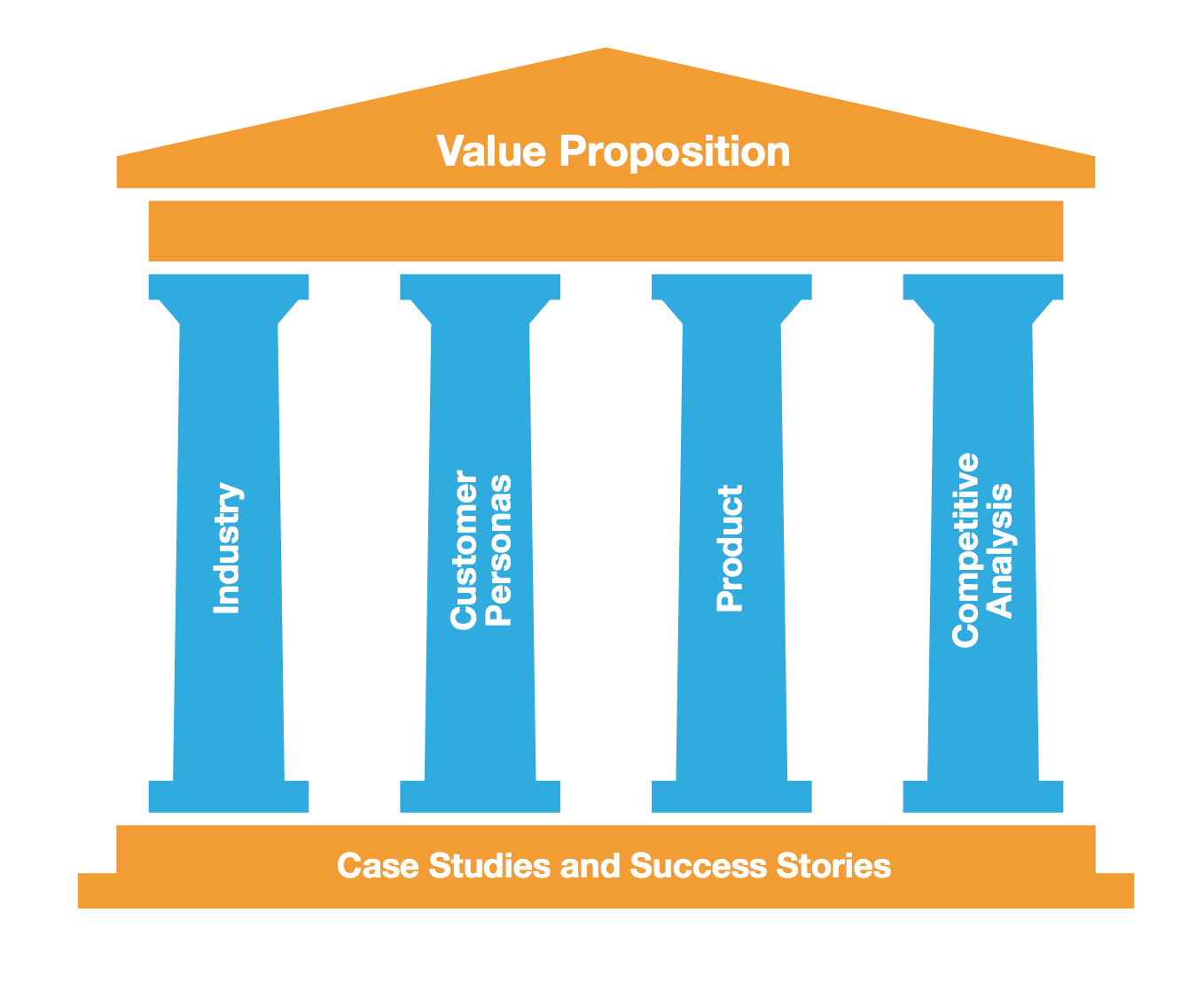The training stage of any sales onboarding program is by far the most important. This is when the new reps learn the essential knowledge that sets the stage for their success in subsequent steps in the onboarding process, and then eventually in their future selling activities.
In order for this “training” to be truly effective, it is extremely important for the company’s product or service to be projected to the new hire from the eyes of the customer – in the context of the customer’s business, industry, challenges, needs, opportunities and pain points. Learning “What to Sell” is much more than just product training or learning how to describe the company’s solutions and services. Rather, it should prepare your reps to articulate the true value proposition behind those offerings when they get in front of a customer.
There are 4 pillars to what to sell:
- Industry
- Customer personas
- Product
- Competitive analysis

These pillars support the articulation of the value proposition and stand on a firm foundation of case studies and success stories.
1. Industry knowledge: setting context from a customer perspective
Before your rep can put your product and their customer’s needs in context, they need to understand your business model and its surrounding ecosystem. This isn’t so much about specific players in the industry, but rather about how your customer sees your industry and what are the first impressions that the customers build as they research the various options available in the market. For example, they may come across influencers in the field, industry bodies and complementary products and service providers, that will all have a role in influencing their thoughts and understanding of how they can solve their specific problem. It’s for this reason that it’s critical for your new sales reps understand your industry and how your customer perceives it.
2. Buyer personas: know your customer
The second pillar is about knowing your customer. Who are they? What are their specific problems? What do they know about how to solve their problem? What is their buying process?
In most businesses, there is more than one customer persona for each product, for example, at Mindtickle we have several different buyer personas and sub-personas as well, that cover differences between customer industries. While the Mindtickle platform may be evaluated and administrated by sales enablement and training professionals, the ultimate approval and decision makers end up sales leaders in fast-growing companies.
For each buyer persona (and sub-persona), the sales rep should understand the type of messages that resonate with them, what channels they research and purchase through, what their specific problems are, and what level of maturity in the buying process they are at. This is all valuable information that forms the basis for how your reps adjust their messaging depending on whom they are interacting with.
3. Know your product as your customer sees It
Knowing your product and its features is only part of this pillar. Your sales reps add value to your customers by not only understanding their product features but by shining a torch on how to apply them to your buyer’s specific needs and issues. They should be asking themselves how does the product solve the buyer’s problem? How often do the customers use the product and for what purpose? What will be the impact on the customer if they purchase this product (for example will it increase their revenue or save time perhaps)?
By not only understanding your product but also its context to the customer, you can make a huge difference to the buyer and also your bottom line. For example, one of our customers discovered that by training their reps not only on the features of its different product offerings but also on how each product met the needs of different customer personas, their sales reps were better equipped to sell to different customers more competently. This gave them a distinct competitive advantage and increased their sales.
For product companies, the most effective and easiest-to-implement process for sales reps to develop an appreciation of the product to have them step into the shoes of the customer and experience the product themselves. While this is not as easy and straightforward to experience for services and solution companies, observing and studying customer stories can be almost as effective.
4. Competitive analysis: understand your worth
One of our customers is one of the fastest-growing technology companies in Silicon Valley and was able to leverage its competitive advantage because it performed an extensive competitive benchmarking exercise and trained its sales reps on the competitive landscape in which it operated.
This goes further than just knowing who your competitors are and looking at how your product stacks up against your competition. Don’t just look at what features your product has that your competitors don’t, but also which customer personas value these features and the use cases and contexts in which each of those relative strengths and weaknesses manifests themselves. For example, if you’re dealing with a customer persona who values analytics and reporting, then they will specifically value knowing that you can make data-driven decision-making easier and more cost-effective for them.
Another component that your new reps should learn about the competitive environment is how to handle customer objections and feature requests. It is quite likely that many of your prospects may also reach to your competitors before making a final decision. Therefore, by understanding their offering your reps will know the context of the objections based on competitor comparisons and be able to rebut them effectively. As a general rule of thumb, about 80% of your objections will be standard and can be trained mostly online. Sales managers can then deal with skill gaps or non-standard objections during the Coaching stage of onboarding.
Bringing it all together: Articulating the core value proposition
Overarching the four pillars is the core value proposition, the promise of why your company and your offering exist. There isn’t just one value proposition for a product or service, but rather multiple tiers that are tailored to different buyer personas, addressing the issues that are relevant to them respectively. By building on the context of the overall industry, understanding the buyer’s specific needs, and how your product can serve that need, your sales rep would be best positioned to create a compelling elevator pitch. While an elevator pitch may only have limited utility, when combined with real customer stories and examples, the deep understanding of the value proposition is an essential ingredient of a compelling and persuasive sales conversation with a prospect.
Finally, bring To life what to sell through case studies and customer stories
Underpinning your pillars and value proposition are case studies and success stories that provide color and context to how to deal with issues out on the field. Observing and listening into real customer calls or demos can be a great opportunity for new reps to see those stories being played out in real action.
Maintaining a library of video recordings of how experienced reps steer customer discussions can also be really valuable as it provides an opportunity for new reps to pick up sound bites and examples that have been tried and tested. In addition, sharing a repository of referenceable customers, case studies and stories can be an invaluable resource for sales reps.
The good news is that most of these “what to sell” components can be learned almost completely online, freeing up time for sales managers to be more involved at other stages of the onboarding process where they can add more value.
Outcomes
If done right, at the end of this stage they should be able to identify and relate with the customer personas, articulate the value proposition as it applies to specific customers and handles the majority of customer objections. This can be validated through online quizzes and mock pitching exercises. By certifying your sales rep at this point, you can see what knowledge they’ve achieved and where there may be some skill gaps to work on. Of course, if they pass their What to Sell certification, you can give them their learners permit knowing they’re on their way to becoming competent and are ready to move onto learning How To Sell.








